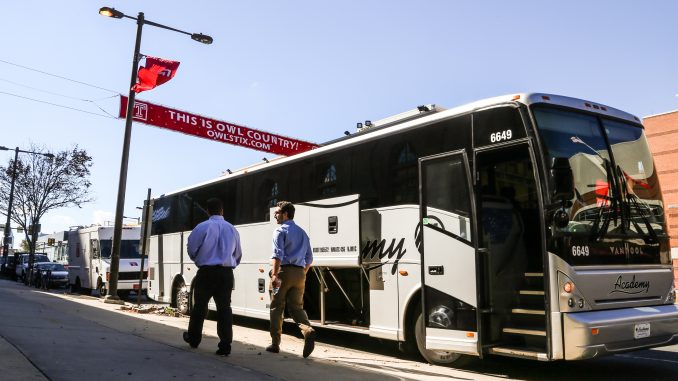
It’s a long ride to the Ambler Sports Complex.
Both of Temple’s soccer teams deal with the 45-minute commute with each home game they play. It’s been the Owls’ destination for home matches since 2004, and sits right next to Ambler Campus, which has an undergraduate enrollment of about 2,300 students.
Junior women’s goalie Shauni Kerkhoff said that playing at Ambler doesn’t always feel like a true home match, especially when considering other Philadelphia schools.
“It’s kind of weird,” Kerkhoff said. “It doesn’t really feel like you’re having home games because you’re traveling. … Games where we play St. Joseph’s La Salle, Villanova, they’re closer than our home field … so it’s really weird because those are away games but they feel like home games.”
Likewise, the University of Pennsylvania and Drexel also have stadiums closer to Main Campus than Ambler.
Now, however, the athletic department has a plan to bring the soccer teams closer to Main Campus.
Temple is planning to utilize part of the former site of William Penn High School, which sits a couple blocks south of campus on Broad Street, between Master Street and Girard Avenue, as the new soccer facility. Temple purchased the property for $15 million this past August after the William Penn Development Coalition fought the sale in July.
Athletic Director Kevin Clark said the university is still in the design phase of the project, but hopes to have the facility up and running within two years.
While some players find the travel challenging, men’s co-captain and sophomore defender Robert Sagel said it’s another aspect of Temple’s identity as a program.
“[The commute] makes for a long day,” Sagel said. “We leave at [2 p.m.], and get back at [7 p.m.] … but that’s part of what makes us ‘us’ … we try to use it to our advantage, and we roll with it.”
Temple’s soccer field is limited by restrictions like no lighting for night games, as well as limited seating, as there are only eight small bleachers on one side of the field.
By comparison, the University of Connecticut’s facility, Joseph J. Morrone Stadium, is a lighted field that seats 5,100.
Like UConn, every other men’s and women’s soccer program in the American Athletic Conference, has stadium lighting and contains more seating than what is offered at Ambler Campus. Most of the fields used in The American sit on campus or a few blocks away from the boundaries of the university.
One exception is East Carolina’s Johnson Soccer Stadium, which lies about a mile south of the center of its campus. But the facility offers a 1,000-seat grandstand, a press box and has a drainage system that can drain 26 inches of rain per hour.
The other outlier is the Mike Rose Soccer Complex, where Memphis plays. It sits about 14 miles southwest of the university, which equates to around a 20-minute drive. Aside from Temple, it’s the longest distance from university to facility in The American.
The main difference is the Tigers’ facility contains 16 FIFA regulation-size soccer fields, as well as a 2,500 seat stadium.
The four million dollar complex covers 136.17 acres and contains fully paved walkways throughout the facility. The central stadium features a skybox, full media services, and a food court, while all sixteen fields have overhead lights.
For the athletes, locker rooms and showers sit inside the stadium structure, as well as administrative offices and a conference room.
The complex has paid dividends for the Tigers since they started competing there in 2001, as both the men’s and women’s programs have combined for 10 seasons with 10 or more wins and four Conference-USA championships.
Bringing the soccer teams right next to campus is a move administrators hope will spark more interest in the programs. Deputy Director of Athletics Pat Kraft described how student involvement is key to driving the increase in awareness.
“The students are what drive that energy,” Kraft said. “The energy they bring, that’s what the focus is for … with any [athletic] department, that’s what brings the energy in the building.”
Similarly, women’s soccer coach Seamus O’Connor said he thinks the new complex will be able to compete with any other facility in the city, in terms of his sport.
“I think it’s going to be the best soccer facility in the city,” O’Connor said. “It will bring fans out not just from Temple, but it will also help in recruiting local kids, as well as foreign players … it’s just going to be huge for our program.”
O’Connor’s squad currently practices exclusively at Edberg-Olson Hall, in order to cut out the commute and also practice at a faster speed than the natural grass field at Ambler.
For men’s coach David MacWilliams and his team, it’s a different story. They split practice between Ambler, the Pavilion, and Edberg-Olson depending on what type of surface they’ll be playing on in their next match.
More importantly, MacWilliams said the lack of an on-campus stadium with lighting can hurt overall fan turnout.
A facility closer to Main Campus could change that, MacWilliams said.
“If you’re playing on campus and under the lights, you’re going to get maybe 1,000, 2,000 [to show up],” he said. “And that’s a great atmosphere for the student-athlete to play under.”
Steve Bohnel can be reached at steve.bohnel@temple.edu and on twitter @SteveSportsGuy1



Be the first to comment